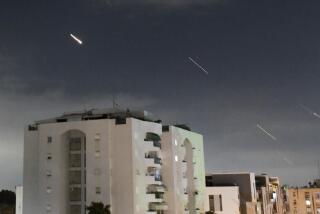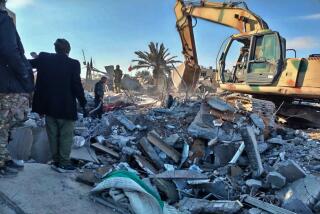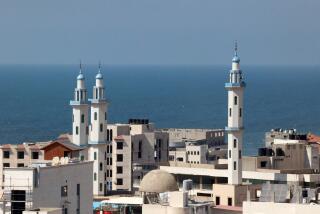Operation Desert Cloud : TRIUMPH WITHOUT VICTORY: The Unreported History of the Persian Gulf War, <i> By the staff of U.S. News and World Report (Times Books/Random House: $25; 450 pp., illustrated)</i>
- Share via
Here are two stories you should have paid 25 cents to read in your local newspaper during the Persian Gulf War, but now have to pay $25 to read in a hardcover book:
* Two days before the ground war was launched, Col. Randolph House’s 2nd Blackjack Brigade was drawn into a trap and ambushed by Iraqi AT-12 tank guns hidden along a wadi’s walls. After a fierce fight, with three of their force killed and nine wounded, the Americans retreated into Saudi Arabia.
* In a “battle for breakfast,” Iraqi tanks, concealed amid the smoke and fires of burning Kuwaiti oil wells, launched an unexpected pre-dawn attack against U.S. Marines. In a counterattack against 30 to 40 enemy vehicles hidden below a ridge line, a 30-year-old ammo loader, Lance Cpl. Keith Beer, threw 15- and 20-pound shells into his tank gun and helped to eradicate the Iraqi force within 20 minutes. “It was like an Olympic sport,” says Cpl. Beer.
Such dramatic tales of American soldiers in action were routine breakfast-table reading during earlier wars, but the entire Persian Gulf War was fraught with overly zealous government censorship. The Pentagon didn’t trust its front-line soldiers to operate alongside reporters. The ground war began with a news blackout and progressed with delayed dispatches and unreasonable and unprecedented restrictions imposed by the Pentagon, particularly the prohibition against journalists accompanying troops.
As we learn in “Triumph Without Victory,” the most comprehensive book written about the Gulf conflict to date, the news reporters assigned to cover Operation Desert Storm were no match for the propaganda machine of the U.S. Central Command and the Pentagon. The authors--editors and reporters at U.S. News and World Report--argue that both the public and the soldiers were ill-served by a policy that sanitized the conflict to the degree that it became largely invisible. The extremely incomplete and limited picture of the war that emerged made it difficult for the public to assess whether to support the war, and impossible for the soldiers to see their bravery rewarded. By restricting news coverage, the Pentagon prevented us from seeing just how tough a battle the Gulf War really was.
In recent months, this policy has come back to haunt the Pentagon and the White House; questions have been raised about critical decisions that left Saddam Hussein in power in Iraq and as truculent as ever. At the same time, young GIs continue to gripe publicly about being the target of “friendly fire” during the brief conflict. The accidental bombardments killed and wounded their comrades in a far higher percentage than in previous wars, further exposing the inaccuracy of the Pentagon’s general assessment that this was a “clean” war.
Washington’s Draconian news management during the war essentially wrote what the authors call the first “rough draft” of Gulf War history. This book is an accomplished second draft. While President Bush repeatedly denied that Washington had ever targeted Saddam Hussein personally, for instance, here U. S. News correspondents report their discovery that on the final night of the war, two American Air Force bombers dropped specially designed 5,000-pound bombs on a command bunker 15 miles northwest of Baghdad in a deliberate attempt to kill the Baathist leader.
“Triumph Without Victory” also offers a vivid combat history woven from interviews with soldiers after the war’s conclusion. U. S. News and World Report staffers around the world have contributed insightful details about the diplomacy that brought a reluctant Soviet Union and most of the world behind the American-led alliance, and kept a wrathful Israel out of the war.
The tank battles of the war, the authors contend, conclusively demonstrate the superiority of American arms and fighting doctrine over the Soviet vintage used by the Iraqis. Only the fearsome Republican Guard units stood and fought, yet they were stunned and ultimately destroyed by the range and accuracy of superior American weaponry. American military tactics emphasizing speed, maneuverability and deception clearly outclassed the plodding Iraqis. Superior American doctrine, implemented with style and courage, explains why the Iraqis were so thoroughly defeated in the ground war.
But then came what the authors see as the premature end to the war: The White House decided to cease hostilities only 100 hours after they began, with the bulk of Saddam Hussein’s foremost forces trapped in “the Basra pocket” near the Kuwaiti border. “You know, those bastards got away,” says Col. John Lemoyne, commander of the First Brigade of the 24th Infantry Division, describing how two Iraqi infantry divisions fled en masse to safety in full view of American tanks after the cease-fire.
The authors cite Arab and Soviet pressure on President Bush to end the war, along with squeamishness in the Pentagon over TV images of destruction on “The Highway of Death.” The authors, however, fail to offer any convincing rebuttal to the Bush Administration’s argument that the Allied mandate was not to destroy Saddam but to kick him out of Kuwait and demolish his weapons of mass destruction.
But the book does solve some lingering mysteries. As I was reporting the opening salvos of the bombing of Baghdad from the Al Rasheed Hotel, for instance, I wondered what Iraq’s formidable air defenses were firing at so furiously when no attacking aircraft were visible. In this book we learn that the U.S. Air Force sent hundreds of pilotless, unarmed drones over the Iraqi capital to decoy the defenses away from the real attacking aircraft.
And when the authors conclude that there were serious flaws in the allied intelligence gathering, they reflect concerns I also felt after witnessing the deliberate bombing of an air-raid shelter in the Amariyah section of Baghdad in which more than 300 civilians died.
“Triumph Without Victory” is a book that needed to be written, but we ought to have seen its brilliant reporting while the fighting was going on. And so we would have, had the Pentagon not closed off the necessary flow of news.
BOOK MARK: For an excerpt from “Triumph Without Victory,” see the Opinion section, Page 2.
More to Read
Sign up for our Book Club newsletter
Get the latest news, events and more from the Los Angeles Times Book Club, and help us get L.A. reading and talking.
You may occasionally receive promotional content from the Los Angeles Times.










